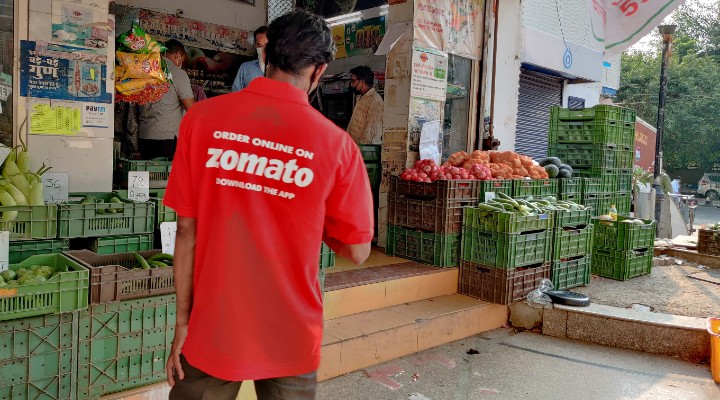Rakesh Kumar, 26, stands in a lengthy queue outside a retail grocery chain store in the southern Indian city of Bangalore during the morning peak hour. His body language is uptight, with a sense of urgency he doesn’t express in words. Kumar, a delivery executive, is waiting to collect the grocery order he needs to deliver within a stipulated time frame. He is part of a massive churning taking place in India, where quick commerce startups are heating up the instant-delivery battlefield with a s
th a string of offers.
The latest to jump on the bandwagon is Ola, a $US7.3 billion Softbank-funded ride-hailing service that is rapidly expanding its footprint into various markets such as food and grocery delivery. Ola kick started its 10-minute delivery pilot operations in April.
The Indian market caught up with the instant delivery phenomenon during the pandemic, catapulted by the surge in digital services and people working from home.
Dozens of startups, both pre-pandemic and newly established ones, capitalised on the trend as they bolstered delivery services in India’s urban centres and hinterlands.
Instant delivery services – powered by the likes of Zepto, Blinkit, Zomato, Swiggy, Dunzo, BigBasket and now Ola – took this to the next level.
Zepto, valued at $US570 million, is a pandemic-born startup launched by two teenage dropouts from Stanford University in California. Its valuation doubled in just two months, underscoring investors’ interest.
Blinkit, formerly known as Grofers and currently valued at $US700 million, is set to merge with Zomato.
Swiggy, Zomato, BigBasket and Ola are relatively established players with well-oiled logistics and supply chains and backed by global marquee investors.
All these digital-first companies deliver staples such as fresh farm vegetables, fruits, dairy items, groceries and more. Similar to cloud kitchens, some of these services are setting up warehouses or ‘dark stores’ but most still rely on retail giants for their operations.
Fierce competition
What has evolved over the last months in quick commerce is the cutthroat ‘winner takes all’ approach of the players.
“As competition in online delivery services increases, companies are striving to decrease delivery times to stand out,” said Vijay Sharma Bhupathiraju, an analyst with the consulting firm GlobalData. “These service providers rely on a team of last-mile delivery executives and micro fulfilment hubs spanning side streets in cities’ neighbourhoods. Few retailers are also partnering with local mum-and-pop stores to fulfil their last-mile deliveries.”
India’s grocery retail is highly fragmented and home to over 15 million mum-and-pop stores, known as Kirana shops. These neighbourhood corner outlets dominate Indian grocery retail, while global and domestic giants like Reliance, Amazon, and Walmart are actively trying to capture a bigger market share.
Govindappa, a store manager at a leading multi-brand retail outlet who did not want to identify his company, said the footfall from customers has declined while the number of delivery executives visiting his store has drastically increased in recent months.
“We have created separate queues and billing counters, and appointed staff especially for the delivery executives, since they require quick attention,” he said.
Industry estimates suggest the Indian quick commerce sector – currently worth about half a billion dollars – will snowball into a $US5 billion market in three years.
“Quick delivery as a concept emerged because of food-delivery aggregators. The thought was, ‘When you can deliver cooked food within 30 minutes, why not supply the ingredients within the same timeframe?’ That’s the genesis,” Kumar said.
Those in the retail world are closely watching the developments and painstakingly calibrating systems to suit the evolving needs.
There is also some backlash against this nascent idea. Some sections of law enforcement and social observers have expressed concerns over potential traffic violations and risks to delivery staff due to the swift rise in quick commerce.
Search for synergy
Rajagopalan, CEO of the Retailers Association of India, a not-for-profit umbrella organisation of retailers of various sizes with over 500,000 member stores, sees advantages and weaknesses at the big and small ends of town.
“While people are already used to home delivery from their Kirana stores, the technology-enabled options are systemising the entire scenario. It is going to change this entire retail ecosystem. Even garments and other everyday items will get delivered shortly,” Rajagopalan said.
“But, anyone who thinks they can become experts in both stocking as well as in delivery may find themselves falling short,” he added, as he cautioned that large companies may be tempted to bite off more they can chew, ignoring local needs.
“Some large players will start competing with the nearby Kirana stores. But, I’m sure the big players will start tying up hyper-local retail stores, which is where the last-mile delivery is,” he added.
“Kirana stores are accustomed to offline retail, while the new entrants and bigger players are stronger in online retail. Customers are now expecting what they want, where they want, whenever they want, and in any which way they want. That’s a challenge,” he explained.
“There should be synergy in co-ordinating and collaborating to deliver to the customer, rather than thinking that one can do it all. The biggest challenge is to have the omnichannel capability.”

